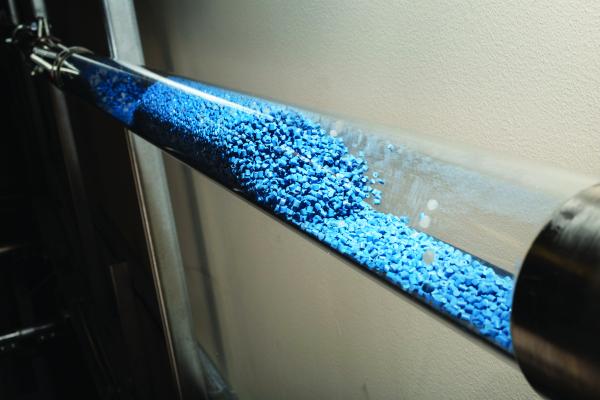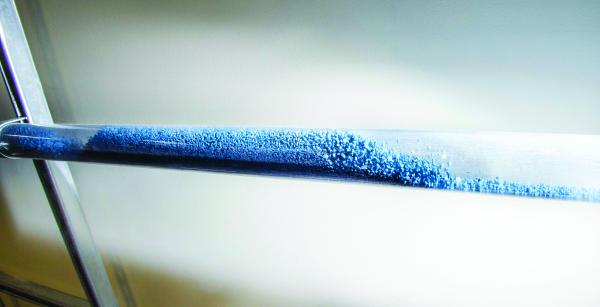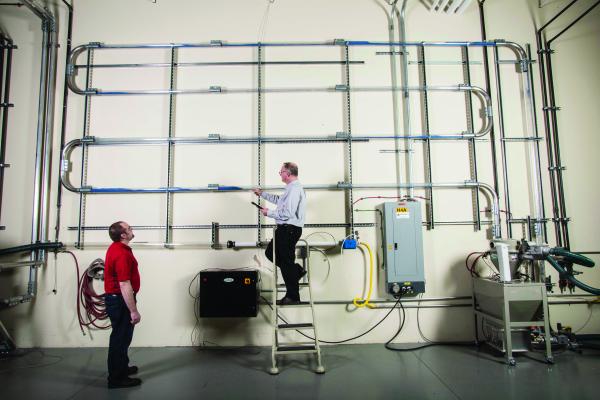A long-held practice in the plastics industry is the use of high-speed, dilute-phase pneumatic conveying to deliver plastic resins to plant processes even if those same materials are the kind that can create problems ranging from excessive dust to damaged resins and more. All the while, slower-speed conveyance is normally unthinkable given production goals and the potential for plugged conveyor lines.
Yet, Conair Group, has developed a system that emphasizes the use of varied speeds –including slow-speed, dense-phase conveying – as way to avoid common pitfalls encountered with sensitive resins and other materials conveyed at high speeds, while also increasing throughput rates and saving energy.

Conair Group’s patent-pending Wave Conveying™ system uses controlled speed conveying to convey sensitive resins and other materials with higher throughput and over longer distances – while avoiding problems encountered with traditional dilute-phase pneumatic conveying systems.
Blower & Vacuum Best Practices Magazine visited with Doug Brewster, Conair Group’s Conveying Product Manager at the company’s plant in Cranberry Township, Pennsylvania, to learn how the company’s system breaks with conventional practices to overcome challenges with materials that don’t stand up to high-speed dilute-phase conveying.
Good morning! Tell us about Conair Group.
We’re a global supplier of auxiliary equipment and solutions for plastics processors. We manufacture 450 different products, including resin-drying systems, blenders, feeders and material-conveying systems, temperature-control equipment and granulators. We also offer a variety of extrusion solutions and we excel at plastics process integration, engineering and the installation of complete manufacturing systems designed to help processors manage raw materials and manufactured parts, while improving process yield.
In addition to our Pennsylvania plant, we have manufacturing, service and sales operations throughout the United States, China and India. We also have sales and service offices in Mexico, Singapore and Taiwan.
Describe conventional, dilute-phase vacuum conveying in use today.
Dilute-phase conveying commonly involves airflow velocities as high as 5,000 to 6,000 feet per minute (fpm) with corresponding vacuum pressures from five to 12 inches of mercury (Hg).
With conventional dilute-phase conveying, materials usually enter the airstream of the system at around 3,000 fpm and then build up to velocities as high as 6,500 fpm.
Conventional dilute-phase conveying like this is very useful and used throughout the world for a wide variety of materials. However, high-speed dilute phase conveying can be problematic with sensitive materials, including common plastics resins like Polyethylene (PE), Polyethylene Terephthalate (PET), Polypropylene (PP) and Polyethylene Terephthalate Glycol (PTEG), as well as well as Long Glass Fiber (LGF) and mineral-filled resins.
Issues with dilute-phase conveying led us to develop a patented dense-phase conveying system we call Wave Conveying™ because it essentially pulls pellets through the conveying line in bursts of slow velocities versus a dilute-phase conveying system where the pellets travel individually through the line at consistently high speeds. It solves a lot of these issues.
Why do problems occur with dilute-phase conveying and sensitive materials? What issues are typically encountered?
It all has to do with what’s happening with materials within a high-speed dilute-phase conveying line.
With dilute-phase conveying, pellets are suspended toward the top of the airstream, while others scrape and slide along the bottom of the conveyor pipe. This creates friction, which generates heat. In turn, it causes the pellets to soften and form angel hair, which are long streamers that can clog the conveying system and block material flow.
At high speeds, there is also a lot of pellet degradation because the pellets collide with each other. They also collide with elbows in the piping. This generates dust, which leads to a number of problems such as product quality and unnecessarily frequent maintenance to clean dust collectors. It also can damage the screws and molds of plastics processing machines. This friction also causes wear in the conveyor lines.
Another issue has to do with the distance from the material pickup point to the process in the plant, which is limited with dilute-phase conveying. When you get beyond 600 feet, positive displacement vacuum pumps either run out of pressure, or the line velocities are so high they create a tremendous amount of dust and/or angel hair. It’s why applications with longer distances typically require the installation of additional equipment, electrical power, and compressed air at an intermediate point to effectively convey materials to the final destination.
Describe Conair Group’s solution and how it differs from a conventional dilute-phase conveying system.
Our system modulates the velocity and density of the material stream pulled through the conveying line so that a higher volume of pellets can be conveyed in slow-moving waves, or what can also be thought of as vertical pistons.

With the Wave conveying system, plastic pellets are conveyed in slow-moving waves over distances of up to 1,000 feet.
Unlike a dilute-phase system, it doesn’t allow for material velocity to increase as it travels further from the source to the destination point. Instead, the operator can control the level of vacuum pressure so the material travels at a consistent velocity from the pickup point to the destination, whether the distance is 50 feet or 1,000 feet.
The system does it by generating two phases of airflow at velocities that are common in dense-phase pneumatic conveying. The velocity range of a phase we call “Wave Stream Flow” is from 300 to 1,000 fpm with vacuum pressures from 12 to 20 Hg. The velocity range of the other phase called “Wave Pulse Flow” is from 1,000 to 2,800 fpm with vacuum pressures from 10-16 Hg.
With these slower phases of airflow, the pellets don’t overcome gravity as they will in a dilute-phase conveying system. Instead, they tumble along the bottom of the conveying line and roll on themselves to form waves. Each wave of pellets, which is separated by air space, results in a denser stream of material. At the end of the day, waves of pellets move fast enough to achieve high throughput but without problems common to dilute-phase conveying because they’re moving at slower speeds.
With the system, dust generation is greatly reduced because there is less pellet degradation. Testing in our R&D lab has shown an 80 to 90 percent reduction in dust generation. The system also eliminates angel hair because there is very little friction and heat build-up at slower speeds. Additionally, we’ve been able to increase throughput by about 10%, which is typically equates to roughly 500 to 3,000 pounds per hour using the same amount of vacuum pump horsepower. With our form of dense-speed conveying, we’ve achieved throughputs of up to 15,000 pounds of materials per hour.
How is the system engineered to address common problems with dilute-phase conveying systems?
I’ll start with the main components of a single system. They include a Programmable Logic Controller (PLC), which serves as the brains of the system; a rotary claw Long-distance Pump (LDP) with Variable Speed Drive (VSD) for producing varied levels of deep vacuum; a materials receiver that stores pre-programmed recipes and communicates with the PLC; a patented pulse valve and a servo valve; a materials distribution box; and a speed sensor.
Users can program the wave pattern, velocity and throughput rate based on specific requirements of each materials receiver. The PLC allows the system to operate in conventional dilute-phase mode, or in both dense- and dilute-phase modes based on the LDP pump and recipe selected. It all depends on the application and what the plant wants to achieve.
The valves works in combination with the PLC and VFD-controlled vacuum pump to achieve optimum vacuum pressure and materials velocity. For example, the valve can be automatically adjusted so the system conveys materials at lower vacuum pressure and lower material velocities in waves when materials need to travel longer distances. Slow-speed conveying allows for conveying materials up to 1,000 feet with a single system.
With the VFD, the LDP pump operates at lower hertz ratings when that’s all that’s needed to achieve the desired materials velocity versus a dilute-phase conveying system where the pump is always running at 60 hertz. Tests in our lab showed the VFD pump saves users anywhere from 15 to 29 percent of energy per kilowatt hour when compared with fixed-speed pumps.
The speed sensor, meanwhile, verifies material is moving slowly from the source to the destination. We also recommend the installation of a clear section of piping to visually inspect materials flow.
The PLC can control up 128 materials receivers and virtually any combination of as many as 40 vacuum pumps, whether the system uses LDP pumps with VFDs for long distances, or standard regenerative and rotary lobe pumps for dilute-phase conveying modes.
Can a dilute-phase conveying system be converted to a wave conveying system?
Yes, and it’s relatively simple since it typically involves minor changes. With an existing system, we’ll usually add the PLC controller, our pulse and servo valves, and the LDP pump, which is needed to convey long distances. The system can work with existing vacuum receivers, hoppers and dust collectors, and tubing, as well as traditional aluminum or stainless steel piping. The vacuum line sizes can range in size with outside diameters from 1.5 inches to five inches. The conveying line also needs to be airtight.
Of course, any retrofit is unique to each company including those who use our brand of dilute-phase conveying systems. And adding an LDP pump still means the system can run in dilute-phase conveying mode when needed.
Our engineers will typically audit the existing system to determine what’s needed. The audit will assess the components of the current system and we’ll forecast the advantages of a retrofit. It depends on what the plant already has in place, the materials they’re using and their goals.
What went into the development of this unique approach to pneumatic conveying?
We were continuing to get calls from companies about dust generation and problems with angel hair and conveying lines wearing out and things that go along with high velocity conveying of plastics resins.

Using a Wave Conveying system at its R&D laboratory in Cranberry Township, Pennsylvania, Conair Group runs sample tests of materials to prove the system’s effectiveness for various customers.
So, we started exploring options. As with any R&D project, we knew what we wanted to do but we weren’t sure how we were going to accomplish it. In 2014, we began sketching out solutions. Extensive work and testing in our lab led to the development of our patented valves, the controller and other key components.
We then introduced the system in 2015. One of our first customers was having all kinds of issues with dilute-phase conveying of PET materials, and dust generation in particular. They sent us material they were conveying and we conducted tests in our lab using our wave conveying system and it solved the problem. There was literally no more dust that would for carry over to the dust collectors.
They were initially saying the system, “Just doesn’t make any sense” when we explained it to them. So we brought them to our lab and showed them the system and how it worked. We also mocked-up the traditional system they had been using and showed how it generated almost nine times as much dust as the wave conveying system. At the point, they said, “We have to have this thing.” They’re now in the process of putting in six more systems at plants throughout the country.
Thank you for these insights.
For more information and videos about Conair Group’s Wave conveying system, visit https://www.conairgroup.com/product/wave-conveying/.
All photos courtesy of Conair Group.
To read similar articles on Pneumatic Conveying Technology visit https://blowervacuumbestpractices.com/technology/conveying.



